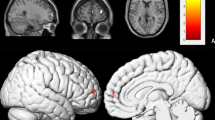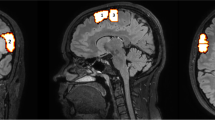Abstract
The aim of this study was to determine the neuropsychological consequences of a middle interhemispheric approach for the removal of tumors of the third or lateral ventricles. A retrospective analysis of eight callosotomized patients for ventricular tumors (three males/five females; mean age: 48.7 ± 11.2 years; education level: 11.9 ± 2.9 years) and eight healthy subjects was performed. An extensive neuropsychological test battery was used to evaluate global intellectual efficiency, memory capacities, executive functions, and interhemispheric transfer of a procedural learning task (serial reaction time task/SRTT). Neuropsychological results showed that: (1) five of eight patients operated through a middle transcallosal approach had disturbances of verbal or visual memory; (2) three of eight patients displayed a dysexecutive cognitive syndrome (two of eight of whom presenting with a deficit of verbal fluency); (3) two of eight patients presented a dysexecutive behavior syndrome; and (4) with regard to the SRTT, although all participants learned the task, in contrast to controls, the callosotomized patients showed an increase in reaction times and an absence of interhemispheric transfer of learning from one hand to the other. The transcallosal approach transects a large number of callosal fibers. This damage accounts for the deficits of memory, the dysexecutive cognitive and behavioral syndrome, and disturbances in interhemispheric transfer of learning.

Similar content being viewed by others
References
De Lacoste MC, Kirkpatrick JB, Ross ED (1985) Topography of the human corpus callosum. J Neuropathol Exp Neurol 44(6):578–591
Peltier J, Verclytte S, Delmaire C, Deramond H, Pruvo JP, Le Gars D, Godefroy O (2010) Microsurgical anatomy of the ventral callosal radiations: new destination, correlations with diffusion tensor imaging fiber-tracking, and clinical relevance. J Neurosurg 112(3):512–519
Rhoton AL Jr (2007) The cerebrum anatomy. Neurosurgery 61(1 Suppl):37–118 (discussion 118–119, review)
Park HJ, Kim JJ, Lee SK, Seok JH, Chun J, Kim DI, Lee JD (2008) Corpus callosal connection mapping using cortical gray matter parcellation and DT-MRI. Hum Brain Mapp 29(5):503–516
Habib M (1998) Corpus callosum disconnection syndromes and functional organization or the corpus callosum in adults. Neurochirurgie 44(1 Suppl):102–109 (Review French)
De Guise E, del Pesce M, Foschi N, Quattrini A, Papo I, Lassonde M (1999) Callosal and cortical contribution to procedural learning. Brain. 122(6):1049–1062
Friedman MA, Meyers CA, Sawaya R (2003) Neuropsychological effects of third ventricle tumor surgery. Neurosurgery 52:791–798
Geffen G, Walsh A, Simpson D, Jeeves M (1980) Comparison of the effects of transcortical and transcallosal removal of intraventricular tumours. Brain 103(4):773–788
Hütter BO, Spetzger U, Bertalanffy H, Gilsbach JM (1997) Cognition and quality of life in patients after transcallosal microsurgery for midline tumors. J Neurosurg Sci 41(1):123–129
Jeeves MA, Simpson DA, Geffen G (1979) Functional consequences of the transcallosal removal of intraventricular tumours. J Neurol Neurosurg Psychiatry 42(2):134–142
Mazza M, di Rienzo A, Costagliola C, Roncone R, Casacchia M, Ricci A et al (2004) The interhemispheric transcallosal transversal approach to the lesions of the anterior and middle third ventricle: surgical validity and neuropsychological evaluation of the outcome. Brain Cogn 55:525–534
Sauerwein HC, Lassonde M (1994) Cognitive and sensori-motor functioning in the absence of the corpus callosum: neuropsychological studies in callosal agenesis and callosotomized patients. Behav Brain Res 20 64(1–2):229–240 (Review)
Cummings JL, Benson DF, Houlihan JP et al (1983) Mutism: loss of neocortical and limbic vocalization. J Nerv Ment Dis 171:255–259
Hodges JR, Carpenter K (1991) Anterograde amnesia with fornix damage following removal of third ventricle colloid cyst. J Neurol Neurosurg Psychiatry 54:633–638
Oepen G, Schulz-Weiling R, Zimmermann P, Birg W, Straesser S, Gilsbach J (1988) Neuropsychological assessment of the transcallosal approach. Eur Arch Psychiatry Neurol Sci 237(6):365–375
Petrucci RJ, Buchheit WA, Woodruff GC, Karian JM, DeFilipp GJ (1987) Transcallosal parafornicial approach for third ventricle tumors: neuropsychological consequences. Neurosurgery 20(3):457–464
Folstein MF, Folstein SE, McHugh PR (1975) “Mini-mental state”. A practical method for grading the cognitive state of patients for the clinician. J Psychiatr Res 12(3):189–198
Godefroy O, Duhamel A, Leclerc X, Saint-Michel T, Henon H, Leys D (1998) Brain-behaviour relationships. Some models and related statistical procedures for the study of brain-damaged patients. Brain 121:1545–1556
Godefroy O, Fickl A, Roussel M, Auribault C, Bugnicourt JM, Lamy C, Canaple S, Petitnicolas G (2011) Is the Montreal Cognitive Assessment superior to the Mini-Mental State Examination to detect post-stroke cognitive impairment? A study with neuropsychological evaluation. Stroke 42:1712–1716
Fazekas F, Ropele S, Enzinger C, Gorani F, Seewann A, Petrovic K, Schmidt R (2005) MTI of white matter hyperintensities. Brain 128(12):2926–2932
Kalafat M, Hugonot-Diener L, Poitrenaud J (2003) Etalonnage français du MMS version GRECO. Rev Neuropsychologie 13:209–236
Nasreddine ZS, Phillips NA, Bédirian V, Charbonneau S, Whitehead V, Collin I, Cummings JL, Chertkow H (2005) The Montreal Cognitive Assessment, MoCA: a brief screening tool for mild cognitive impairment. J Am Geriatr Soc 53(4):695–699
Godefroy O, Azouvi P, Robert P, Roussel M, LeGall D, Meulemans T (2010) Dysexecutive syndrome: diagnostic criteria and validation study. Groupe de Réflexion sur l’Evaluation des Fonctions Exécutives Study Group. Ann Neurol 68(6):855–864
Raven JC (1965) Guide to using the coloured progressive matrices. Lewis, London
Beauregard J (1971) Le test des automatismes verbaux. Editions scientifiques et psychotechniques, Issy les Moulineaux
Deloche G, Hannequin D (1997) Test de Dénomination Orale de 80 images. Centre de psychologie appliquée, Paris
De Renzi E, Vignolo LA (1962) The token test: a sensitive test to detect receptive disturbances in aphasics. Brain 85:665–678
Rey A (1970) Test de Copie et de Reproduction de Mémoire de figures Géométriques Complexes. Centre de Psychologie appliquée, Paris
Grober E, Buschke H, Crystal H, Bang S, Dresner R (1988) Screening for dementia by memory testing. Neurology 38(6):900–903
Godefroy O, Roussel-Pieronne M (2007) La batterie GREFEX: données normatives, in Godefroy et les membres du GREFEX (eds) Fonctions exécutives et Pathologies Neurologiques et psychiatriques. Solal, Marseille, pp 231–252
Perez MA, Wise SP, Willingham DT, Cohen LG (2007) Neurophysiological mechanisms involved in transfer of procedural knowledge. J Neurosci 27(5):1045–1053
Cardebat D, Doyon B, Puel M, Goulet P, Joanette Y (1990) Formal and semantic lexical evocation in normal subjects. Performance and dynamics of production as a function of sex, age and educational level. Acta Neurol Belg 90(4):207–217 (French)
Nelson HE (1976) A modified card sorting test sensitive to frontal lobe defects. Cortex 12(4):313–324
Test TM (1944) Army individual test. War Department Adjutant General’s office, Washington, DC
Stuss DT, Floden D, Alexander MP, Levine B, Katz D (2001) Stroop performance in focal lesion patients: dissociation of processes and frontal lobe lesion location. Neuropsychologia 39(8):771–786
Baddeley A, Della Sala S, Papagno C, Spinnler H (1997) Dual-task performance in dysexecutive and nondysexecutive patients with a frontal lesion. Neuropsychology 11(2):187–194
Burgess PW, Shallice T (1996) Bizarre responses, rule detection and frontal lobe lesions. Cotex 32:241–259
Mamelak AN, Barbaro NM, Walker JA, Laxer KD (1993) Corpus callosotomy: a quantitative study of the extent of resection, seizure control, and neuropsychological outcome. J Neurosurg 79(5):688–695
Sass KJ, Spencer DD, Spencer SS et al (1988) Corpus callosotomy for epilepsy. II. Neurologic and neuropsychological outcome. Neurology 38:24–28
Siwanuwatn R, Deshmukh P, Feiz-Erfan I et al (2005) Microsurgical anatomy of the transcallosal anterior interforniceal approach to the third ventricle. Neurosurgery 56:390–396
Clark CR, Geffen GM (1989) Corpus callosum surgery and recent memory. A review. Brain 112(1):165–175 (Review)
Benes V (1982) Sequelae of transcallosal surgery. Child’s Brain 9:69–72
Leiguarda R, Strakstein S, Berthier M (1989) Anterior callosal haemorrhage. A partial interhemispheric disconnection syndrome. Brain 112:1019–1037
Lassonde M, Sauerwein C (1997) Neuropsychological outcome of corpus callosotomy in children and adolescents. J Neurosurg Sci 41:67–73
Godefroy O, Roussel M, Leclerc X, Leys D (2009) Deficit of episodic memory: anatomy and related patterns in stroke patients. Eur Neurol 61:223–229
Wheeler MA, Stuss DT, Tulving E (1995) Frontal lobe damage produces episodic memory impairment. J Int Neuropsychol Soc 1:525–536
Conflicts of interest
None.
Author information
Authors and Affiliations
Corresponding author
Rights and permissions
About this article
Cite this article
Peltier, J., Roussel, M., Gerard, Y. et al. Functional consequences of a section of the anterior part of the body of the corpus callosum: evidence from an interhemispheric transcallosal approach. J Neurol 259, 1860–1867 (2012). https://doi.org/10.1007/s00415-012-6421-x
Received:
Revised:
Accepted:
Published:
Issue Date:
DOI: https://doi.org/10.1007/s00415-012-6421-x




